Abstract
Dhauti, or Kunjal Kriya /Vaman Dhauti/ViV (Voluntarily Induced Vomiting) is one of the yogic techniques for stomach cleansing described in ‘Gherand Samhita and Hathyogpradipika. Dhauti involves drinking a stomach full of water in the morning with an empty stomach soon after leaving the bed, followed by voluntarily inducing vomiting to puke out the water. Dhauti is usually adopted in Ayurveda for healthy weight loss, reducing kapha dosha. The present study aims to understand the popularity of ‘Dhauti Kriya among people who are aware of and are practicing holistic approaches such as yoga for health benefits. A survey has been made using a questionnaire using Google Forms. Of the 1200 communications sent, 202 people responded, of which 109 (54%) have Dhauti experience. 55 persons felt fresh after Dhauti, 42 felt a light stomach after Dhauti and 52 persons performed Dhauti successfully on their first attempt; almost a dozen people expressed affirmatively that they would recommend ‘Dhauti’ to others directly, and none opposed. Both males and females with equal proportions could perform Dhauti at ease. This observational survey indicated that ‘Dhauti’ is being adopted by people for their health benefit..
Keywords: Dhauti; Vomiting; Stomach-Cleaning Practice; Hathayoga; Weight Loss
Introduction
At present, science is more aware of the health of internal organs and secretions. However, very few routine processes are present in modern medicine for cleaning internal organs. This was given by Ayurveda and Yogic epics [1]. Dhauti is one of the cleaning techniques given in ancient epics [2]. Dhauti is one of the Shatkarmas that is gaining more and more popularity in a short period because of its cleaning power [3]. The study investigates the performance aspects of the ancient technique of Dhauti [4]. It is a stomach-cleaning practice [5] detailed in Hathayoga [6] that involves consuming large quantities of water followed by ‘Dhauti’ through finger stimulation of the throat. Carnivore animals perform ‘Dhauti’ Naturally [7]. Animals drink water and eat grass, and they invoke Nausea and further do ‘Dhauti.’ Although traditionally associated with benefits such as employing Dhauti as one of the weight loss methods [4], it reduces Kapha, decreases acidity, and increases vital capacity [1], and weight loss, Dhauti remains underutilized due to its unconventional nature.
Dhauti is used for preventing migraine attacks [8], physiological healer [9], balancing amla pitta [2], purifying body and skin [10], balancing Tirosh [11]. Still, its usage is not fully explored by modern medical science except for poison expulsion during stomach poisoning [12]. Dhauti also has some minor challenges, such as increased blood pressure; sometimes, it will reduce craving excessively. Till now, no explicit study has been carried out on awareness of Dhauti. This survey-based study involved 202 participants between 18 and 65 years of age. It includes males and females. These participants are from those pools of friends, relatives, and known people who are in touch with the author directly or through social media [13].
The study investigates subjective responses to their experiences in association with Dhauti. Out of 202 participants, 109 participants have already completed Dhauti successfully. 12 people have asked inquisitively to know in detail what is ‘Dhauti’. The survey proforma revealed that over 40% of participants experienced a ‘clean stomach,’ 21% found the process ‘very easy,’ 61% found it easy, and more than 48% successfully performed Dhauti on their first attempt. The study suggests that Dhauti can potentially become a widely accepted and beneficial stomach-cleaning technique despite its current lack of popularity. This is because of its ease of adaptation, economical technique, selfusage, and development of internal senses like cleaning. The study showed that those people who have answered “NO” are also want to aware of ‘Dhauti.’ People are learning natural techniques from carnivore animals. Animals are closer to nature. While conversing with different people, it was also observed that people want to go towards a natural way of treating their body cleanliness and hygiene.
Objective
• To know whether people know about Dhauti and to know people’s inquisitiveness about Dhauti or cleaning techniques?
• What were the assumptions of the participants about Dhauti before performing Dhauti.
• Gender-wise analysis of successful Dhauti implementation.
• To analyze what % of people adapt Dhauti for the first time, second time, or what iterators try Dhauti to become successful?
• Can people recommend Dhauti, if recommended, then with a physician’s help, self-driven, or with a yoga instructor?
• How is Dhauti’s first feeling? How do they feel it was?
• Why have people performed Dhauti? Reason.
Materials and Methods
Those who know partially about yoga. Mixed subjects to represent society around. It contains male females between 18 and 60 years of age. Data Questions were formulated per suggestions from different experts, guides and Ayurvedic doctors, yoga experts to determine the adaptation of Dhauti. The following data is collected from participants
• Email Address
• Gender
• Have You done Dhauti?
• How was your feeling after performing Dhauti?
• In how many attempts you could perform Dhauti?
• How was your learning experience?
• How was your assumption prior to performing Dhauti?
• Will you Recommend Dhauti To your friends, Relatives, or others?
• What is the purpose of performing Dhauti?
Subjects Chosen are from• Having some idea about yoga.
• Are in touch with the author through social media and/ or personally.
• Are from age group of 18+ Yrs to 65 Years.
• Males as well as Females both are included
Requests communication was sent, including the Google form link to the questionnaire. The Data was Collected in Google form. Participants have been sent a small note about the data collection and its purpose. In case the participant asked about Dhauti, details about Dhauti and a YouTube link explaining Dhauti were sent to them. On received responses analysis was carried out in Excel, google pivot tables, and graphs were developed, and interpretation was done on that basis.
Results and Discussion
Response from People
(Figure 1) indicates how people have responded to time lapses. 12 people enquired, ‘I do not know, but can you tell me about it?’. People are curious. A detailed write-up and YouTube link recorded were given to such people to make them aware of the Dhauti process.
How many People have Performed Dhauti at least Once (Y/N Analysis)
(Figure 2) shows the number of people who have given a response (YES/NO) to the question,” Have you performed Dhauti?”. There were 202 responses, out of which Dhauti was successfully performed by 109 people. That means around 54% have attempted Dhauti as well as they know Dhauti and were successful.
• Statistical Analysis of Male-Female Ratio
a. % Ratio: As 51 females and 58 males out of 109 people have performed Dhauti, the ratio is 46.78 to 53.22, which is nearly 50% each and comparable.
b. Chi-square test: H0=Null hypothesis= Frequency of equality is not same, H1=Frequency is Same
To try for the Null hypothesis, the Expected values taken
1. In the following (Table 1), we considered that the malefemale ratio is (0.75,0.25) as the expected value.
2. Away from (0.5,0.5). It shows the possibility of only 0.01, which is 1%. So, the Null Hypothesis is rejected.
Degree of Freedom=(r-1) (c-1) = 2-1=1
X = Root of X2 =6.8
Contingency Table Value at 6.8 =0.01
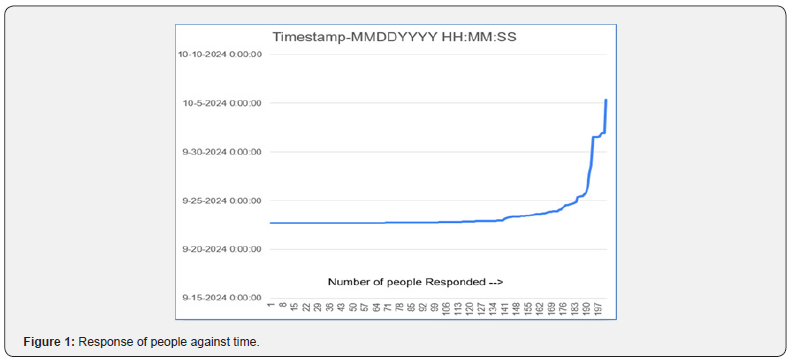

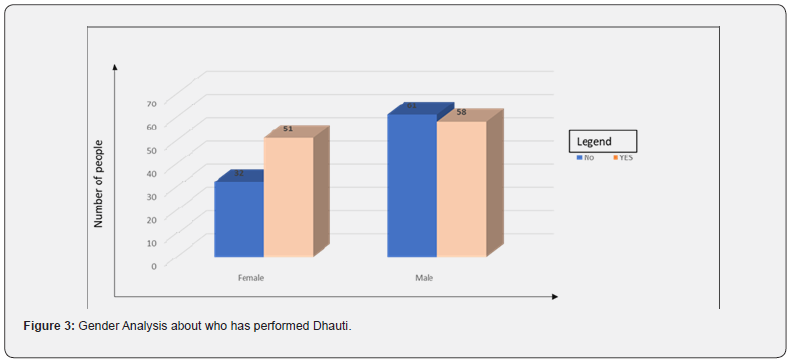
Similarly, when we calculate the Chi-Square test for the malefemale ratio (0.66,0.33) as expected values, the contingency table value comes to 0.04, which is 4%, as given in (Table 2).
Degree of Freedom=(r-1) (c-1) =2-1=1
X = Root of X2 =4.40
Contingency Table Value at 4.4 =0.04
Similarly, the actual observed value is calculated as 0.45, which is 45%, as given in the table below. So, the possibility of a male-female comparable number is 45%, as observed in the table. These details are given in (Table 3).
Degree of Freedom=(r-1) (c-1) =2-1=1
X = Root of X2 =0.67
Contingency Table Value at 0.67 =0.45
So, conclusively, as the observed value suggests, there is a 45% probability that the male-female number will be comparable.
Gender Analysis Dhauti’s Performance
(Figure 3) suggests that the percentage of males and females who have performed Dhauti successfully, 58 vs. 51, are comparable. Also, the female-yes ratio is more than the male-yes ratio. (Table 4) indicates that Males and Females are equally happy and positive concerning their feelings about Dhauti. Males and females feeling fresh are equally comparable. Males were found to have cleaner stomachs than females. (Table 5) indicates that Males and females seem to be equally easy, very easy, or equally difficult. Most of the males and females are comparably equally afraid, curious, or hesitant about Dhauti. Most of the Males were curious about it. (Table 6) shows that many males and females consider this to be the same as another cleaning process. (Table 7) indicates that males seem to be advising (51) more than females (47), whereas males and females think that they rarely go for a doctor’s advice. This also indicates that trust in yoga advisers is increasing or may be with their experience. Males and females are equally recommending Dhauti to others.
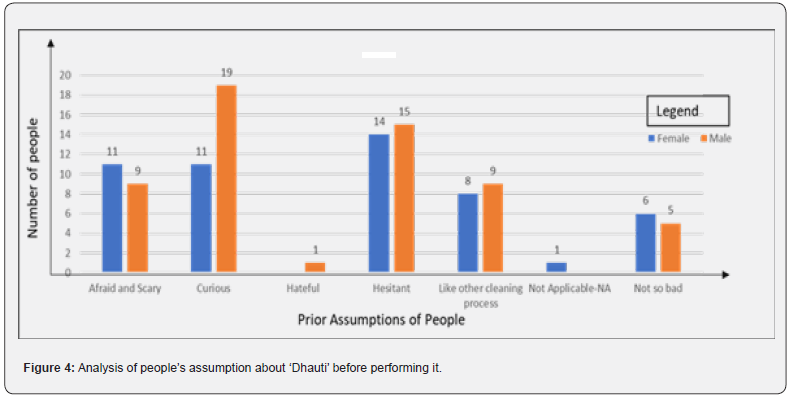


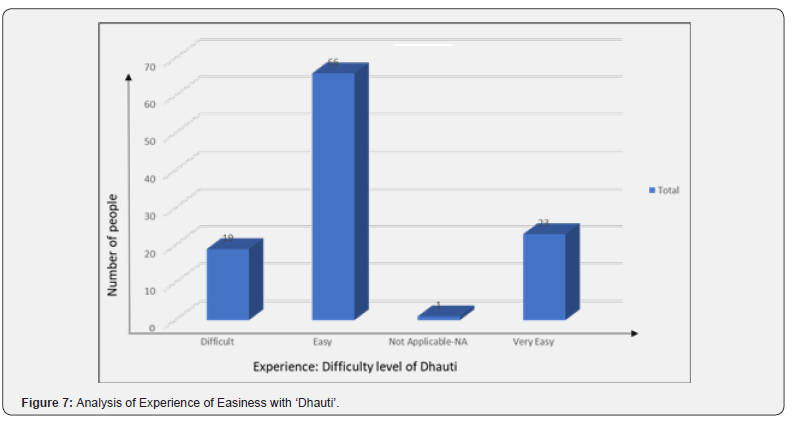
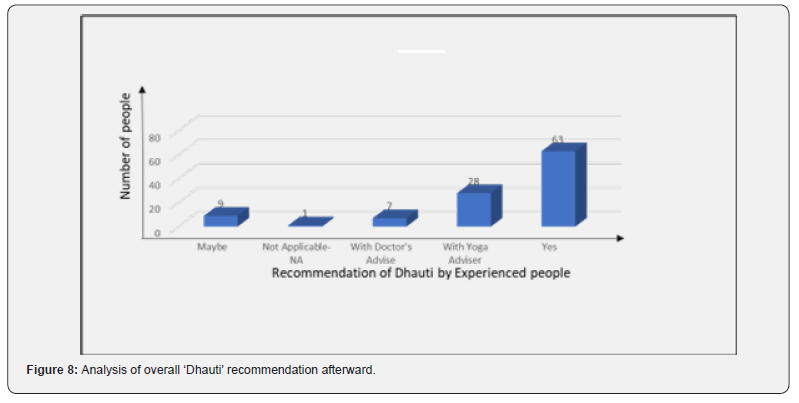
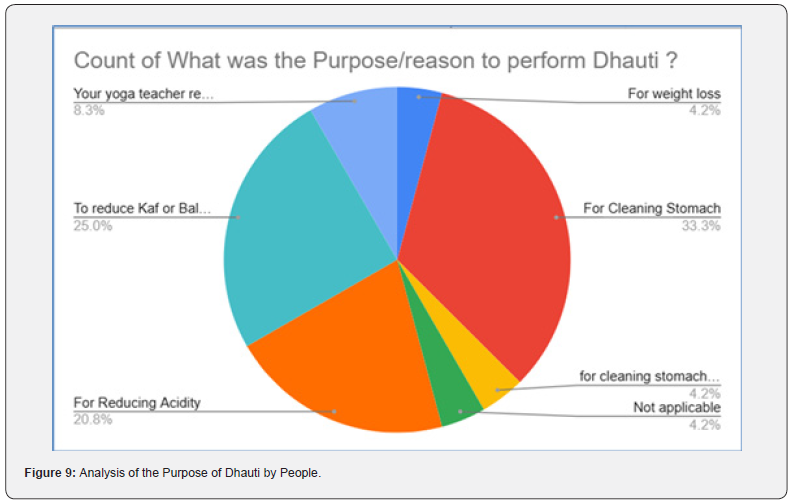
Prior Assumption about Dhauti
(Figure 4) There are 78 out of 109 are positive about Dhauti. This is 71% of the total number of people who have done Dhauti successfully. This shows people’s positive awareness of Dhauti. (Table 8) indicates that most of those who were afraid, scared, curious (27%), and hesitant about Dhauti in prior situations have recommended Dhauti directly. There, 30% were hesitant to do so. All of them have done Dhauti successfully. Of those people who were afraid and scared, almost 60% (12) of them recommended Dhauti afterward. Of those who were hesitant, 51% of them also recommended Dhauti. Of those who felt ‘Not So Bad’, 72% (8/11) recommended Dhauti. Very few people recommended ‘With Doctor’s advice’, meaning they consider this could be done with self-help. Only 1% of people were hateful, but did Dhauti successfully. Most people who were hesitant, curious, or scared (12+16=28) recommended Dhauti afterward.

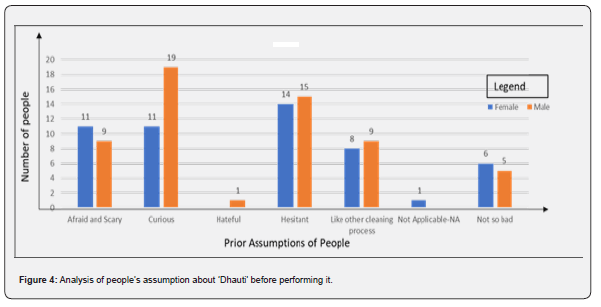
People who were ‘Afraid or Scared,’ ‘Hesitant,’ who thought it was ‘like another cleaning process’ have recommended performing Dhauti with a ‘Yoga Adviser.’ For the ‘Yoga adviser/ teacher’ might have played an important role. (Table 9) indicates that those hesitant before Dhauti felt clean stomachs afterward. Most people who were curious about Dhauti, 19/30, felt fresh afterward. Most people who felt afraid and scared felt fresh and clean stomachs afterward. (Table 10) specifies that most people, regardless of whether they were afraid, scared, hesitant, or felt okay, succeeded in the first or second attempt. People curious or felt Dhauti was ‘not so bad’ also went to more than five attempts. As given in (Table 11), out of the people who were feeling negative about Dhauti, 86% changed their minds, and then they recommended Dhauti, which is 40% of the total people who were successful about Dhauti. This is a very good conversion rate. This clearly indicates that people get convinced after Dhauti that it is a better cleaning technique.
How was the First Feeling After Dhauti?
(Figure 5) Most of the people, 55(28+27) out of 109(51%), were feeling fresh. 44(18+26) out of 109(42%) were feeling a Clean Stomach. Very few/negligible people hate it or respond that they will not do it again. 104/109 (95%) people had positive feelings about Dhauti. 48 Females and 56 males out of 109 were positive about it. This means that the number of males and females with positive feelings is almost comparable overall. (Table 12) specifies that most First attempt people are feeling (A clean Stomach, Fresh, and happy to do it. Some people have gone beyond five attempts and made it successful; further, they felt fresh, and some felt a clean stomach. (Table 13) specifies that most people who felt Dhauti easy or very easy felt “Clean Stomach” or “Fresh” after Dhauti. (Table 14) indicates 81% of people out of successfully done ‘Dhauti’ have recommended Dhauti whose Feeling was ‘Clean Stomach’ or ‘Fresh’. (Figure 6) indicates that 51% people out of successful people have done Dhauti successfully on their first attempt in life, and 20% have done it the second time. In all, 71% of people have done Dhauti successfully in the first or second attempt. It means 20% of people who were not successful had hope that they may be successful a second time, and they have attempted. This may be because of the partial feeling they have about its benefits. Some people have attempted more than 5, which is a commendable commitment.







Experience of Easiness
(Figure 7) specifies that 20% of people found it very easy, and 64% found it Easy. Overall, 84% of people found it easy or very easy, which is quite a good number, and 19% found it difficult for successful people. Only 0.8% of people found it very, very difficult.
Recommendations by Experienced People
There are 90% people out of the total successful people have recommended Dhauti. What was the recommendation for people who have never done Dhauti? Almost 10% of people recommended doing it with a Yoga Adviser. However, nobody has recommended a Physician. This indicates that people are more oriented toward yoga advisers nowadays. (Figure 8) indicates that 70% of people accepted that they would recommend ‘Dhauti’ to others directly. So, these subjects are confident about the effect of ‘Dhauti’. 47% of people give advice that they want to advise ‘Dhauti’ with the help of a Yoga Adviser. There 14% of people have not confirmed whether they will recommend ‘Dhauti’. Only 7% of people said they would recommend it with the help of a Physician or Doctor. This means that people think a Yoga adviser is enough to teach ‘Dhauti’ or a Yoga adviser can be a better option. Of those who have not done Dhauti but have some idea about it, 20% of them advised to perform ‘Dhauti’ with a Yoga adviser’s help. It is surprising to know that 5% of people advise ‘Dhauti’ though they have not done it, considering the effectiveness of cleaning.
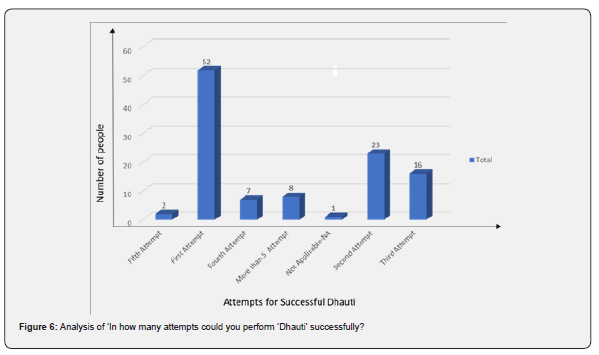


What Purpose of Dhati People have
When enquired people having Dhauti done successfully, they responded with the purpose of it. (Figure 9) indicates that most people have the purpose of “Cleaning the Stomach.” Below that, people also did Dhauti to reduce Kaph dosh and balance tri dosh. In this question, only 24 out of 109 respondents responded afterward (figure 9).

Inquisitiveness about Dhauti
12 people have reverted with questions, ‘I do not know about Dhauti, but I heard this word, and I want to know more about it’. Such people have been sent with details of Dhauti and a link to YouTube explaining Dhauti in detail.
Conclusion
• Awareness is increasing as more people are becoming more aware of Dhauti than expected, and people are adopting it as an effective cleaning technique.
• People are more inquisitive regarding natural cleaning techniques and techniques from ancient epics. Some people have heard the name Dhauti but do not know what it is.
• There is the conversion of people from anti to pro- Dhauti, as seen in the data.
• Males and females are comparable in number who perform Dhauti Successfully.
People who were curious and scared also further did Dhauti successfully, and they are recommending Dhauti as a stomachcleaning technique.
dropdown Start here
References
- Yadav SK, Joshi N (2021) An Ayurvedic Perspective of Hrid Dhauti in Shatkarmas and its Impact upon Human Physiology. Dev Sanskriti Interdisciplinary International Journal 17: 36-42.
- BV Rekha, Balvantbhai CK (2022) Impact of Vamana dhauti in Amalapitta: A Critical Review. International Journal of Medicine and Public Health 12(1): 8-11.
- Swathi PS, Raghavendra BR, Saoji AA (2021) Health and therapeutic benefits of Shatkarma: A narrative review of scientific studies. Journal of Ayurveda and Integrative Medicine 12(1): 206-212.
- Vd Gayatri K, Halmare, Vd VG Patrikar (2019) Effect of Jal Dhauti on Sthaulya W.S.R. To Obesity: A Systemetic Review. World Journal of Pharmaceutical Research 9(1): 1571-1579.
- Yogeshwar G (1992) Kunjara - the yogic stomach wash. Ancient Science of Life 12(1-2): 261-263.
- Sarvesh Kumar Agrawal, Hatha yoga pradipika. Chaukhamba Orientalia, Varanasi, India.
- Tello L, Perez-Freytes R (2017) Fluid and Electrolyte Therapy During Vomiting and Diarrhea. The Veterinary Clinics of North America. Small Animal Practice 47(2): 505-519.
- Halappa N (2019) ‘Prevention of chronic migraine attacks with acupuncture and Vamana Dhauti (yogic therapeutic self-induced emesis) interventions’, International Journal of Yoga 12(1): 84-88.
- Rasool A, Verma S (2021) Dhauti: A Physiological Healer in Human Physiological System. RESEARCH REVIEW International Journal of Multidisciplinary 6(9): 60-66.
- Vd Kiran Sharma, Vd Duragwati Devi (2019) Purification of Bodyand Skin Through Kunjal (Jala Dhauti) And Neti Kriya. International Journal of Research in Medical Sciences and Technology 8(1).
- Wenyi F, Gudapti P, Giri Kumar PV (2019) Immediate Effect of Vaman Dhauti on Tridosa (As Measured by Nadi Tarangini)-A Pre-Post Control Study. indianyoga.org, India.
- Johansson AK, Tonje Mjanger Øvretvedt, Karen Knudsen Reinholtsen, Anders Johansson (2022) Eating Disorders: An Analysis of Self-Induced Vomiting, Binge Eating, and Oral Hygiene Behavior. International Journal of Clinical Practice. Edited by R. Amaral Mendes 2022: 6210372.
- Parmhans Swami Anant Bharti, Gherand Samhita. Chaukhamba Orientalia, Delhi, India.






























